Wonder Wednesday 140: Paint with the Wind

What do Nature, Paul Klee, & Paint have to do with each other?
At first I might say sure Klee and paint is an obvious match, but that was before I learned that Paul Klee was quite the naturalist! Did you know that beyond being an amazing and groundbreaking Creative with a capital C artist of the Bauhaus and more, that Klee (pronounced like "klay") wrote multiple theoretical articles and even a book on nature observation?
The Paul Klee Notebooks V.2: The Nature of Nature (originally, Infinite Natural History) was published in 1923. In this exploration Klee draws on his keen observations of nature and applies that to the development of his personal style, which he describes as being developed in the context of cosmic history (cosmic being used here in the science way like Maria Montessori or Carl Sagan used it, like the cosmos, systems based thinking, and ecological literacy).

Klee explains how he is intrigued to explore the "earthly-cosmic tension" between gravity on Earth and non-gravity in the cosmos and how this contrast inspires him to stylistically set his forms as if they are either in the absence or presence of gravitation. Knowing this, we can understand how his paintings feel all at once free floating and grounded.

Klee elaborates on the inseparable connection between artist and nature when he says, "For the artist, dialogue with nature remains a conditio sine qua non. The artist is a man, himself nature and a part of nature in natural space. But the ways that this man pursues both in his production and in the related study of nature may vary, both in number and in kind, according to his view of his own position in this natural space." (Paul Klee, Ways to Study Nature 1923)

Klee continues with,
"...there are other ways of looking into the object which go still farther, which lead to a humanization of the object and create, between the ‘I’ and the object, a resonance surpassing all optical foundations. There is the non-optical way of intimate physical contact, earthbound, that reaches the eye of the artist from below, and there is the non-optical contact through the cosmic bond that descends from above...by swimming and flying, we free-ourselves from constraint in pure mobility."
I really feel this simultaneously, swimming - grounded and surrounded by water and flying - lifted and supported by air, free and mobile feeling when I look at Paul Klee's paintings. What about you?
How can Klee's ideas inspire nature journaling?
Well, the way it gelled for me this month was I saw a video of someone using pencils attached to tree branches to harness the creative power of the wind to draw. I though that this was a really cool idea and wanted to try it, but also wanted to take it further art-wise and then contextualize it within art history - because it's all about context right? Plus, collaboration with nature is super cool!

Paint with the Wind!
So this Wonder Wednesday 140 in a contextualized collaboration with art history and nature, we're combining wind, pencils, imagination, and paint!
The process goes: the wind will sketch for us, we'll define the wind's sketches in ways that please our eye, we'll look at those defined lines to see what images appear to float out of the lines to our eyes, and finally we paint them in!
2 mammals, 2 birds, 3 fish, and a volcano floated up out of my lines - Can you find them?
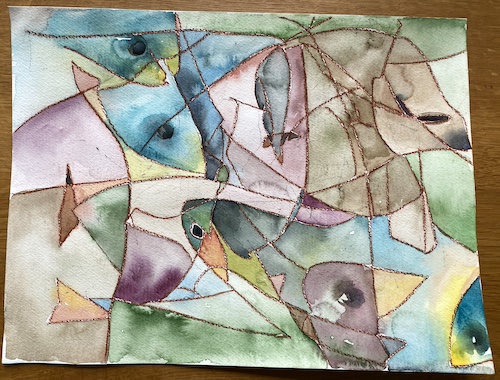
& Once the wind draws the first layer for you, but before you start defining the wind's preliminary sketches, I invite you consider Paul Klee's interest in the way all life on Earth and the entire cosmos are connected!
Consider how metaphorically swimming and flying through our connections, collaborations, and creativity "we free-ourselves from constraint in pure mobility".
Where might that level of gravity free cosmic freedom lead your art and nature experiences? Let's find out!
Wonder Wednesday 140: Paint with the Wind
This project has 2 parts. So if you do this with children, or even just yourself, you may want to do the project in 2 sessions - especially since we need wind and the day that is windy enough may not be the day you have the space for art making!
I recommend this project for ages 9+. I think it could be a bit frustrating for many children younger than age 9 - but it all very much depends on the individual child!
Materials
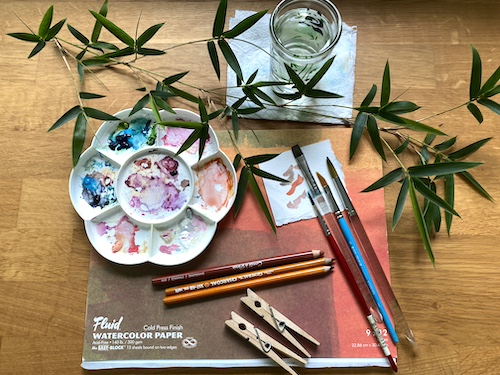
A Windy day
A tree, shrub, or some kind of sturdier plant
A surface adjacent to the breezy branches - like a table - or if that isn't available, a tray to hold the paper under the branches
2 Clothespins
Watercolor or mixed media paper
2 Pencils (I used charcoal pencils because I wanted to experiment, but regular pencils are great too.)
1 Color pencil, whatever color you like (I technically used a conté pencil in the color "sanguine", because again I was in the mood, but any thicker type of pencil works great. Waxier pencils will create a nice resist.)
Watercolor paint
Paintbrushes
Water
Preparation
Harness the creativity of the wind!
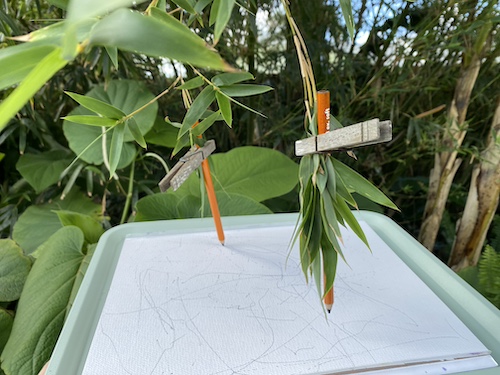
This step can be a bit fiddly, so be patient getting it set up.
Tip - depending on your tree or shrub (or lack there of in my case; I used bamboo), you may need to hold the page up to the pencils on a tray or clipboard if the branches aren't near, or compatible with, the table or surface available.
I held the paper up to the bamboo on a tray here.
On a windy day:
1. Attach, in the best way you can fashion, the pencils to the tree branches using the clothes pins.
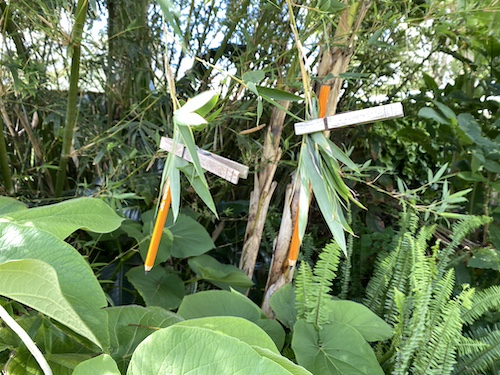
2. Depending on your scenario, place the paper on the surface or hold the paper up to the branches and allow the wind to sketch!

3. Let the wind draw for as long as you like, or like the looks of what the wind is drawing!
Feel free to help the wind by rotating your paper, changing the angle, or adjusting the pencils accordingly.
We don't have to be wind sketch purists here!

4. Once you think the wind sketch is complete, remove the paper and set aside for painting.
You can let the wind make as many sketches as you like in this step.
If you want, try experimenting with different writing utensils - from pencils to markers to even chalk!
Procedure
5. Once you have your wind sketch and are ready to paint, take some time to clear your mind and look at the overall wind sketch as a whole.
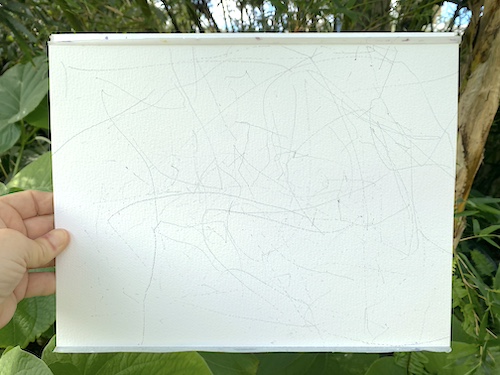
6. Then, take your color pencil and begin to darken and define lines and line connection areas that stand out to your eye and that you like the shapes and forms of - but don't try to specifically make any images out of the lines and forms just yet.
Stay in the abstracted, aka Klee's "non-gravitational", zone at this point in the process.

7. Next, before you start painting, take a few more minutes to gaze at the defined lines and forms. What imagery swims and flies through your eyes and into your imagination?
Think about this step like how Klee describes it - "...there are other ways of looking into the object which go still farther, which lead to a humanization of the object and create, between the ‘I’ and the object, a resonance surpassing all optical foundations."
How do the abstracted shapes, lines, and forms, align, become representational, and even anthropomorphize in our minds?
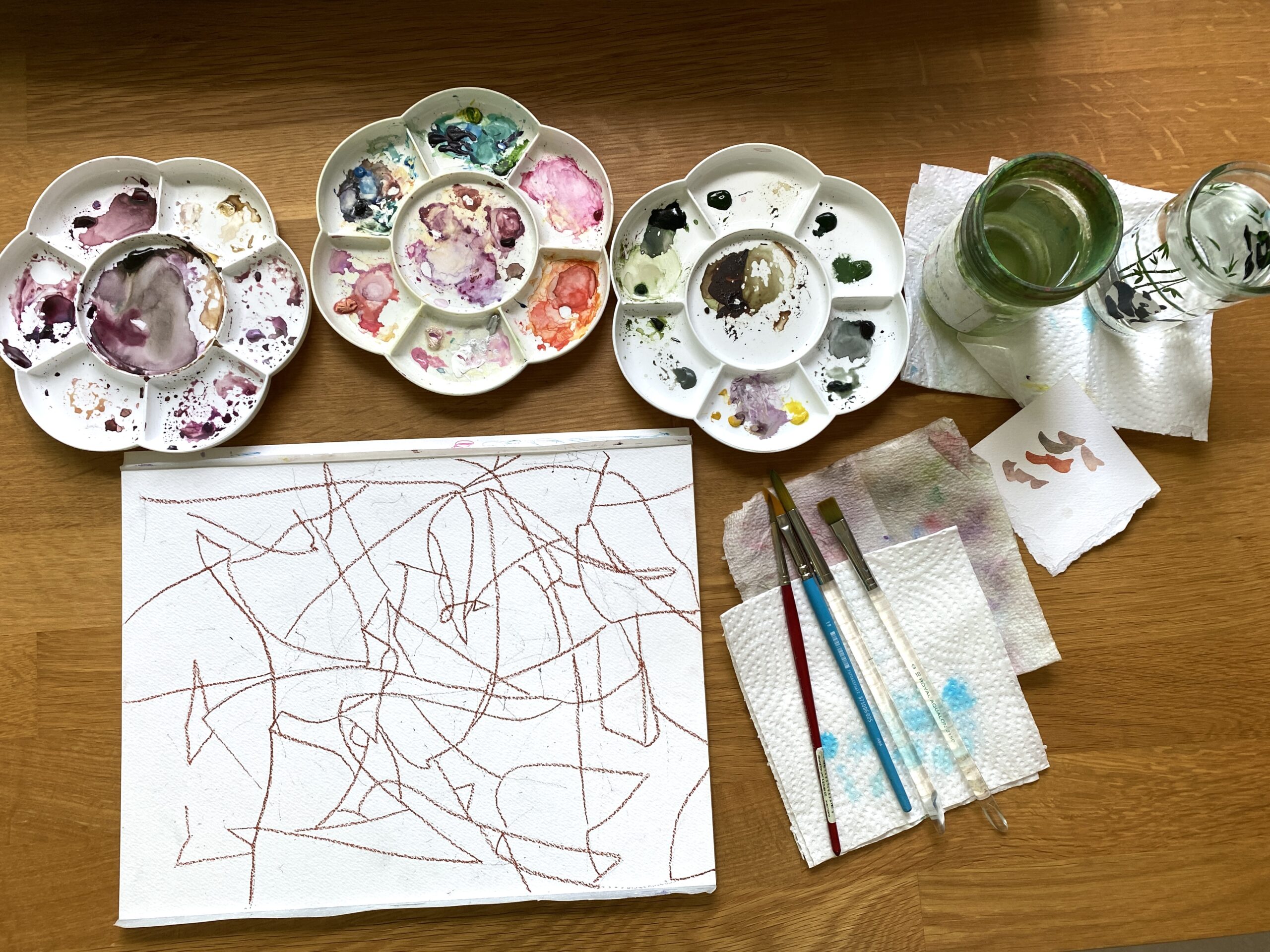
8. Let's paint!
Paint the forms you saw in the abstracted shapes and lines into more representational connected stylized nature forms and imagery!
Animals, plants, landforms...anything goes!

9. Feel free to turn your page around and look from different angles and perspectives. Images and forms will likely continue to pop out as you go along. Add them as you like!

In mine, the mouse and the sloth appeared at the beginning, the toucan-ish bird came to me in stages, & the fish, duck, and volcano didn't reveal themselves to me until after I started painting.
I was actually really surprised it was almost all animals and no plants came to me considering I prefer to paint plants over animals.
Consider which colors will make the shapes designated as the background or negative space receed and allow the nature forms to pop.

10. Extensions
- As you paint, feel free to embellish with painterly details over top of the lines - notice how I added the eyes to the fish and duck using paint without regard to the lines drawn.
-You could even add pen details or doodles a lá Paul Klee once dry.
- Play with the depth of the painting by allowing the paint to make gradations within the shape forms, especially in the background shapes or in areas of an image that may be in shadow (such as the chest of the sloth in my image).
This will give the image as a whole that grounded, yet floating feel, of which Klee was such a master.
- Trade artwork with a friend and see if you can find their images!
Were you able to find my 2 mammals, 3 fish, 2 birds, and 1 volcano? Can you find them now?

Seeds to Sprout:

Abstract Expressionist Prints
In this oldy but goody Wonder Wednesday 7 project we explore abstract expressionism through painted leaf prints. This one is great for all ages. And - the child in the photos turned 14 yesterday! That show's you how long I've been at this!

Shadow Portraits
Another old favorite here! In this Wonder Wednesday 98, we're draw the ephemeral shadows we find! And to keep with the nostalgia, the child in this one is about to turn 20! Stay tuned to youtube as well because I have updated this project into a video painting tutorial!

Explore Color
Explore more about art history and how artists use color and form in abstracted and representational ways in the Explore color series!
In part 2 we look at some Masters of Color and then experiment with their ideas. In part 3 we explore our colors in nature and own nature inspired seasonal color palettes!
